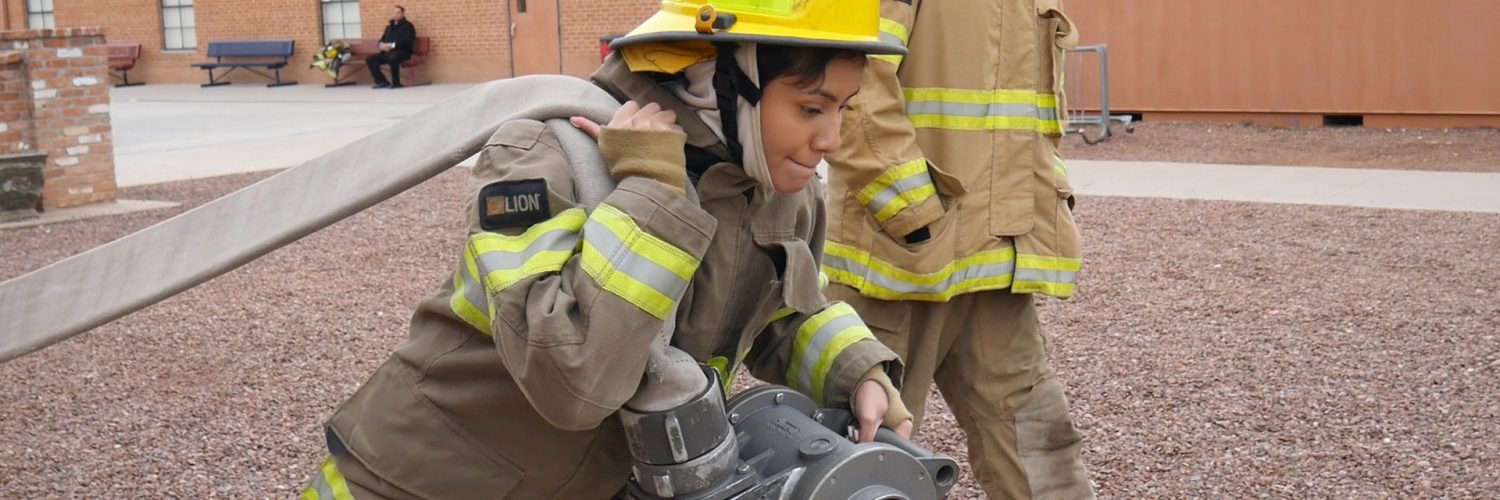Decked out in their firefighters uniforms and awaiting their signal, a group of juniors at Franklin Police and Fire High School attentively hold their positions. They hear the word “go” and immediately spring into action: unfurling a lengthy fire hose, dragging a heavy practice dummy, and swinging a bulky sledgehammer as quickly as possible.
Thirty minutes later, they’re sitting in classrooms learning English, math and science like any other high school student.
Franklin Police and Fire was the first high school in the country to have dedicated law enforcement and fire science programs when it opened in 2007, and those programs are still a big part of what makes the school unique. But despite having “police and fire” in its name, the true focus of Franklin Police and Fire High School is preparing students for “college, career and life,” according to Principal Lorenzo Cabrera.
“We see ourselves as a college prep school,” Cabrera said. “So we push everyone to complete high school and go to college.”
The numbers don’t lie: within each of the last eight years, between 95 and 100 percent of Franklin’s senior class have graduated high school, and 100 percent of outgoing seniors have applied to universities. Cabrera said that in addition to requiring students to apply to in-state universities, they also push them to apply to their “dream school” and pursue financial aid and scholarships.
Many Franklin graduates who don’t go to college enlist in the military or pursue other routes, and a few have even been able to secure entry-level law enforcement positions within a few years of graduation.
“We have a great partnership with MCSO, and so some of our graduates have an opportunity to be detention officers with the sheriff’s office,” he said.
Students participating in either the police or fire programs at Franklin get exposed to a lot of the ideas and skills they would need if they were to pursue a career in either field. For law enforcement students, that can include everything from learning to read Miranda Rights to how to interpret police codes. Fire science students, meanwhile, learn everything from fire suppression techniques to how to conduct search and rescue operations.
The public safety programs are taught by former police officers and firefighters, who Cabrera referred to as “experts in their trade.”
Angelina Ortiz, a junior at Franklin, said she hopes to someday work as a forensics pathologist for a law enforcement agency. She said that she values her connections with the faculty at Franklin and feels like they truly care about the students.
“Our teachers are really connected with us, we do a lot of one-on-one if we need any help with our subjects,” she said. “I don’t think you get that much attention at other schools or campuses.”
Ortiz also said that she’s noticed a strong sense of community that permeates the walls of Franklin.
“I would have to say that we’re a family,” she said. “We’re really supportive of each other in anything that we do.”
A particular focus of Cabrera has been getting more young women interested in public safety careers. While public safety is still a “male-dominated profession,” he said, Franklin Police and Fire currently has almost as many female students as it does male students. Cabrera said Franklin encourages females to consider the profession via programs like Camp Franklin, an womens summer camp led by female officers and firefighters.
“That’s been a push of mine, to get these young ladies into public safety, because I know that a lot of them are interested in it,” he said.
Franklin Police and Fire is a Title 1 school, meaning many of its students come from families classified as at or below the federal poverty line. But Cabrera said that what really makes Franklin students stand out is their eagerness to work hard and overcome the obstacles in their path.
“We don’t allow that specific demographic to determine their destination,” Cabrera said. “We’re really proud of our students and what they’ve accomplished, and their resiliency.”
Franklin Police and Fire has also been repeatedly recognized as a top-performing school by U.S. News & World Report, is an “A-rated” school according to the Arizona Department of Education, and has even been designated a National Blue Ribbon School by the U.S. Department of Education.
“I’ve said that we are the Valley’s best-kept secret,” Cabrera said, “but we shouldn’t be.”
















Add comment